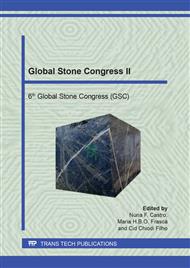p.101
p.109
p.119
p.127
p.137
p.145
p.157
p.165
p.174
Stone Materials and Old Buildings: How Observations can Help to Preserve the Past for the Future
Abstract:
Through the observation of the set of monuments of cultural heritage built in stone, it can be seen important ornamental or covering applications. From macroscopic descriptions performed in these monuments, a great variety and different intensities of alteration processes are observed, mainly when comparisons are made between monuments located in large and small urban centers. These alterations and degradations, in part conditioned by the mineralogical composition and the structures present in these stone materials, are strongly influenced by the conditions of the environment. In general, the set of alterations and degradations observed are those related to the decomposition of the minerals that make up these rocks. Based on these in-situ investigations, diagnostics can be produced on the degree of degradation of stone materials and recommendations for their conservation
Info:
Periodical:
Pages:
174-186
Citation:
Online since:
June 2020
Authors:
Keywords:
Price:
Сopyright:
© 2020 Trans Tech Publications Ltd. All Rights Reserved
Share:
Citation:


